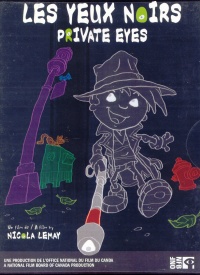| ________________
CM . . . . Volume XVIII Number 20 . . . . January 27, 2012
excerpt:
This film is an adaptation by animator Nicole Lemay of the children’s book by author Gilles Tibo. It tells the story of Matthew, a super detective, who is on a mission to find his birthday present. Through this engaging story and the 3D stereoscopic line drawings, the viewer is also exposed to life with a visual impairment. The film provides insight and awareness about how children with visual impairment can use sound, smell, taste, and touch to gather information and learn about the world. The use of animation in the film facilitates the expression of abstract concepts in a more concrete way. For example, the concept that a visually impaired child’s other senses can compensate for a lack of vision, as expressed in the above excerpts, is pictured very concretely in the film – drawings of eyes actually appear physically on Matthew’s ears, nose, mouth, hands and feet as he describes what he perceives through these senses. In this way, young children can better understand how a smell can conjure an image or how a sound can identify a location. The visual aspects of the film also convey features of visual impairment. The screen is always totally black with white line drawings and very little colour. This gives the impression of images arising out of darkness. The animated line drawings are also created around the characters as the scene progresses (there is probably a more technical way to describe what I mean here, but animation is not my area of expertise!). In addition to the completely black background, this gradual development of the picture mirrors how Matthew perceives individual aspects of his environment and then eventually is able to put the scene together. This ability is particularly emphasized during the sequence when Matthew is showing his father a shortcut for getting to school. As Matthew describes what he hears or smells in order to know which way to turn or walk, the buildings, fences, and other landmarks appear around them, and the intriguing way that blind people can navigate the street, and other outdoor environments, is revealed. Other aspects of visual impairment are also incorporated into the film in a very naturalistic way. At the outset, the opening credits are first presented in Braille, followed by French and then English print. This immediately catches the viewers’ attention and alerts them to an important aspect of the story. Early on in the film, Matthew determines what time it is by pressing a button on his watch that “speaks” the time for him. This indirectly provides information about the kinds of devices that are available for people with visual impairments. Matthew begs his parents to give him clues about his birthday present, and, when they do give in, they do not use visual descriptors, but rather indicate that it is “something you have wanted for a long time”, or “it is soft” or “warm”. Similarly, the way we often use visual words to express something non-visual, like “feelings” is also addressed in a humourous way in the film. When Matthew’s mother says, “I love you both – anyone can see that”, Matthew jokingly replies, “Yeah, Mom, so can I!” Although the purpose of the film is to promote awareness of the abilities of children with visual impairments, it does so through an interesting and engaging story. The role of detective seems to be a recurring theme with blind characters. Could this be because it provides a way to emphasize the powers of observation through other senses? Or does the stereotype of talking into a microphone provide an opportunity to record what the characters are thinking and perceiving in a more explicit manner? Regardless of the reason, it is an effective way to portray the abilities of blind children within a valued role. Overall, the film is entertaining and informative and provides an excellent way to increase children’s awareness of what it is like to live with a visual impairment. Highly Recommended. Charlotte Enns teaches in the Faculty of Education at the University of Manitoba, and conducts research related to literacy development of Deaf children.
To comment
on this title or this review, send mail to cm@umanitoba.ca.
Copyright © the Manitoba Library Association. Reproduction for personal
use is permitted only if this copyright notice is maintained. Any
other reproduction is prohibited without permission.
NEXT REVIEW |
TABLE OF CONTENTS FOR THIS ISSUE
- January 27, 2012.
AUTHORS |
TITLES |
MEDIA REVIEWS |
PROFILES |
BACK ISSUES |
SEARCH |
CMARCHIVE |
HOME |
